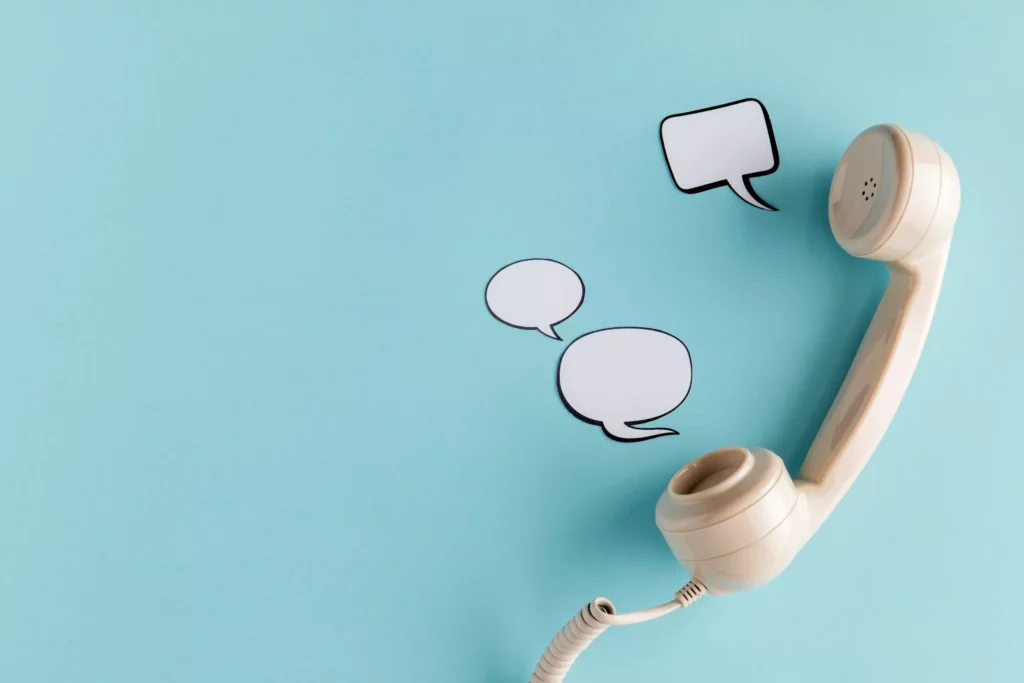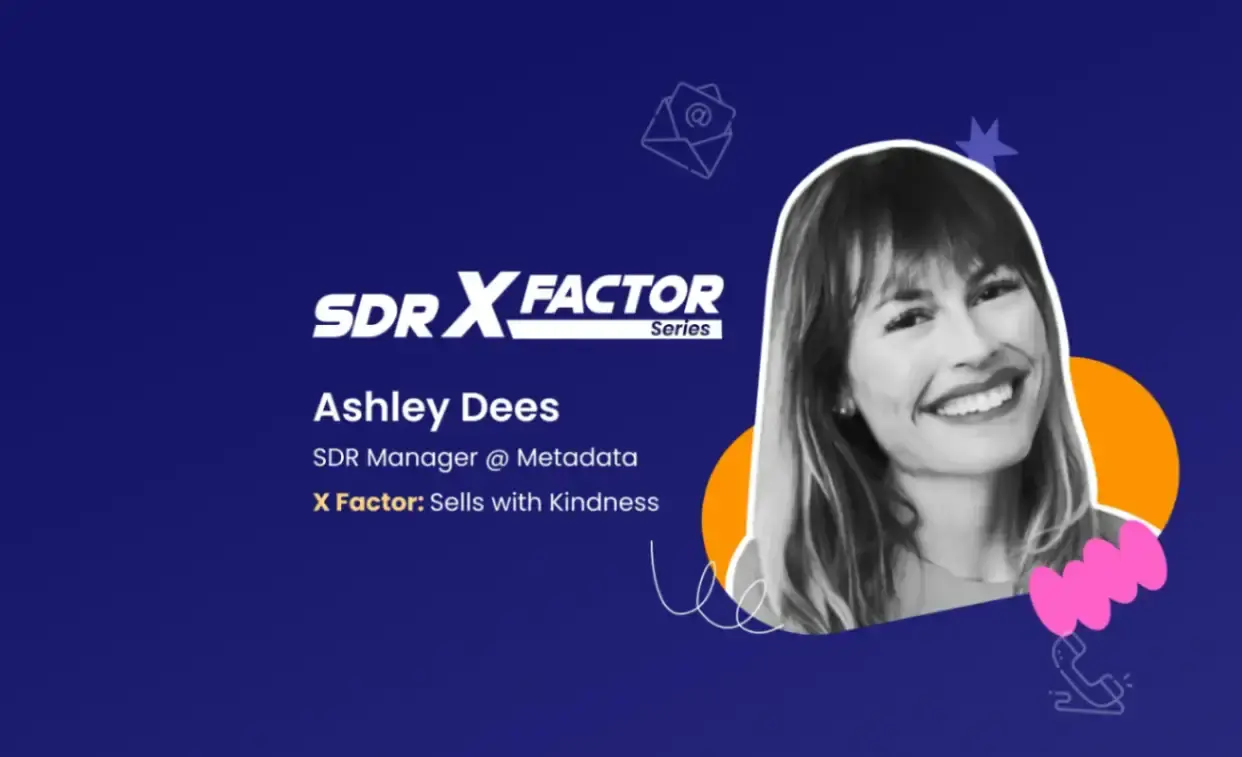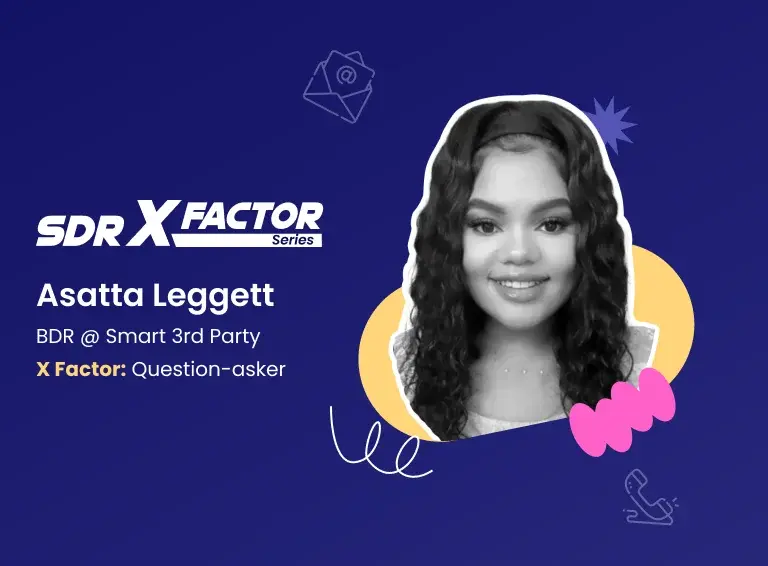The SDR X Factor is a series of long-form stories that aims to reveal what sets top-performing sales reps apart. How do they go about their day? What do their cold calling and cold emailing strategies look like? How are they crushing quota every time? We extract their key strategies, tips and tricks so you can sell better.
For the first installment of this series, we’re joined by Ashley Dees, a Sales Development Representative (SDR) Manager at Metadata, a demand generation platform for B2B marketers. With nearly 8 years of experience in sales, she has worked in several roles in her career so far— she’s been an SDR, Account Executive, and now, an SDR Manager.
We trace her journey from being a beginner SDR who hated cold calling to becoming a quota-exceeding SDR Manager. How did she learn to love cold calling? How has fears of a recession impacted her sales outreach? Ashley answers these questions, and explains how she breaks a few rules as a top-performing SDR.
1. From an SDR to a Top-Performing Manager

A top-performing salesperson, like Rome, is not built in a day. It took Ashley courage to face her initial failures and keep trying to improve daily.
In her first job as an SDR at a startup, even though she enjoyed the process, things didn’t come easily to her. “I was terrible on the phone, absolutely horrible. Very awkward, couldn't hold a conversation,” she remembers. Immediately, she follows with a smile, “But I loved it.”
Seeing her SDR colleague being good at cold calling, Ashley’s competitive spirit got the best of her, and she decided to be better than him.
“I would listen to this person and try to learn from him as best I could and mirror and copy the things that he would do. That's when I fell in love with sales and it evolved from there.”
From there, she moved to an Account Executive role at a San Francisco-based company before joining Metadata in an SDR role. Within 2 years, Ashley became an SDR Manager and now manages a team of SDRs, in addition to booking meetings and carrying out outbound prospecting herself.
She and her team managed to exceed their quota for October 2022, booking around 105% of the meetings.
Amid fears of an upcoming recession, she explains that outbound prospecting has often turned rough for SDRs as prospects bring up budget constraints in response to sales pitches. “Right now, we're just super focused on getting these inbound meetings that we get converted because, luckily at our company, we get a high volume of inbound demo requests.”
What Sets Her Apart?
a) Emphasizes Kindness Toward Prospects in All Situations
In the hustle and bustle of selling, Ashley doesn’t forget that kindness helps a salesperson build trust with prospects. With tech companies big and small slashing jobs, if a prospect she contacts tells her that they have been laid off recently, she’d volunteer to share her company’s job board with the person and even put their name on the board to help them find a new job quickly.
Whether it’s during objection handling, reaching the wrong person on a call, or even dealing with gatekeepers, she tries to be nice to the person she’s interacting with in any situation. Apart from building trust, such acts of kindness will get the person to help her.
“People are always happy to help when you're nice, in my opinion. If you're sweet to people and just genuine to say, ‘Hey, can you help me?’ people are always happy to help,”
b) Being Genuinely Excited About the Product She’s Selling
“I will never work at a company where I'm not very excited about what they're doing,” Ashley asserts. Being genuinely excited about her company and the product is what helps her sell better to her prospects and book more meetings. This occurs due to the “transfer of enthusiasm,” as she likes to put it. “I get very excited about the product that I'm selling, so I enjoy getting other people excited about it too.”
c) Creates Time Blocks and Avoids Task Switching
Ashley creates time blocks as part of her daily work routine to segment her tasks. There will be separate time blocks for tasks such as prospecting, cold calling, checking her email inbox, and going through LinkedIn. Each block will be an hour or two as per her requirement.
Within these time blocks, she takes care not to switch between tasks — like sending emails within the cold calling time block. “I find that it's inefficient, and you wasted a lot of time going back and forth in between SDR tasks,” she elaborates.
d) Plans the Month With Specific Number of Meetings Booked as Target
Being the SDR Manager, Ashley starts her work by checking her dashboard that displays the number of meetings booked by her and her team of SDRs. She fixes the monthly target at the start of every month, and every day, she distributes the pending number of meetings between her and her team members to ensure that the quota is met.
2. How Ashley Aces the Cold Calling Game
Cold calling is a number's game, but that shouldn't be at the cost of pre-call research. At the start of her career, Ashley used to target making 100 cold calls every day. “I wasn't preparing as much before each call, which I think is really important,” she says.
Now, she cold calls only 30 prospects in a day. This gives her ample time to research each prospect before calling. “I know exactly who they are, what their company does, and things they might be interested in.”
So, how does Ashley run cold calls to book meetings successfully? Let’s find out:

i) Warms up the Call in Any Way Possible — From Arranging Dinner Parties To Emailing Content
The cold calls Ashley makes aren’t all that cold. She tries to warm it up in one way or another. One of her ways is throwing a dinner party for customers and inviting a list of prospective clients via calls. “Let's say three people answer. Whether they come to the dinner or not, doesn't really matter that much. I'll keep track of those three people and put tags on them. Those leads are semi-warmed up because they know you now,” she explains. Now, if she calls those prospects, they will likely have a conversation.
Another way she recommends is to ask prospects during the call whether you could share any sales enablement content that’s relevant to them, something on the lines of, “Hey, we just published this cool report for marketers, it's got all these neat KPIs on LinkedIn ads and Facebook ads. I was hoping I can send that to you. Would that be okay?” This way, SDRs will warm the prospects up a bit, and it'll be much easier to get them to say yes during the second call, she elaborates.
ii) Uses Permission-Based Openers During the Call
In line with her usual approach of being kind and authentic while calling prospects, Ashley always uses permission-based openers like “Do you have a minute to chat?” or “Is it a good time to talk?” at the beginning of the call. Her introduction would typically go something like, “Hey, Kim! Ashley from Metadata. We haven't spoken before. Do you have a minute to chat?”
“People take it more as a sign of respect, that you're making sure it's okay to continue your pitch when you call them out of the blue,” she notes.
Sometimes, if she hears over the phone that the prospect is in a noisy environment like being stuck in traffic, she’d immediately modify her opener a bit to say, “It sounds like it's not a great time. Sounds like you're driving and I don't want to bother you. Is it okay if I call you back tomorrow afternoon?” This has worked for her well, because this gives the impression that she’s respectful of the prospect’s time, making them more willing to talk to her when she calls back.
iii) Handles Objections Through Lightheartedness:
When it comes to objection handling, Ashley not only does it with a smile but tries to put a smile on the prospect’s face as well. By keeping her responses to objections lighthearted, she manages to keep the conversation going.
“When I'm reaching out to people, I like to have fun. I think the most satisfying part of our job is that we can do silly stuff and be creative, and I really enjoy making people laugh personally. So anytime I'm able to do that, I will,” she says.
Let’s look at some of the objection handling techniques she shared in action:
a) Objection: “I’m Not the Right Person.”
If Ashley reaches a person who is not the intended prospect, she quickly searches for their name on LinkedIn while being on the line. There, she pulls up a snippet of information about them, like the university they went to — UCLA, for instance — and would Google fun facts about that.
“I'll say, ‘Did you know that the first mascot at UCLA was a jellyfish?’ Just something silly,” she says. This usually gets a laugh from the person on the other side of the line and keeps the conversation going.
b) Objection: “I’m Not the Decision Maker.”
This is a variation of the previous objection. Most of the time, Ashley says she would research the prospect well enough to see if her product would be a good fit for their role, and she would make this clear in her response to this objection before pitching to them. “If I call somebody, I want to talk to them. it doesn't matter if they do the check on the contract or if they're the ones that sign off,” she points out.
c) Objection: “We Already Have a Solution in Place.”
To this, Ashley would ask questions to “unpack” this objection. Some of the questions she asks the prospects are:
- “What solution are you using?”
- “What are you using it for?”
- “Are you happy with it?”
- “Are there any other challenges your team is having right now?”
Based on the answers to these, she’d formulate how her solution would be helpful and address their pain points.
d) Objection: “This Is Not the Right Time.”
This is the objection that she hears from her prospects the most while cold calling. She keeps her response simple: “I don't want you to be late. When can I call you back? Will tomorrow at the same time be okay?” and reschedules the call.
However, prospects tend to not attend the rescheduled calls, and this is something that’d require persistent follow-ups. “Set a reminder on that two days later, two days later, two days later, and eventually they do answer, and they'll remember,” she says.
iv) Explains Her Position to Gatekeepers
“At the end of the day, they're just people trying to do their jobs.” This is how Ashley views gatekeepers and it shapes her approach to handling them. When gatekeepers refuse to transfer her call to the prospect, she explains her need to contact this person, and asks for suggestions from them.
She would tell them something along the lines of, “I wouldn't ask you to do that because I don’t want you to get in trouble. But, my boss is asking me to reach out to somebody from this account. What do you think I should do?” By sounding kind and vulnerable, most gatekeepers help her out with suggestions.
v) Finds Interesting Details About the Prospect To Build Rapport
To build rapport, Ashley tries to find anything interesting about the prospect while researching them on LinkedIn, like their interests, articles they wrote, or podcasts featuring them. Then, she brings it up during the call by mentioning specific details, like: “I read your article on this. I thought #5 was really cool, where you mentioned how important experimentation is in emails.” This generally leaves the prospects impressed and makes them want to continue the conversation with her.
vi) Ashley’s Tips From Her Successful Cold Calling Journey:
a) Take a Break After a Bad Call
Not all calls are bound to go well. If SDRs run calls with prospects who turn out to be quite hostile, Ashley recommends not doing the next call immediately and taking a quick break for 10-15 minutes. Spending time with your pets or taking a walk during this break will help you clear your mind and move on to the next call.
b) Call Prospects on Their Mobile Line
Ashley recommends calling the prospect directly using their cell phone number instead of calling business lines to improve your cold calling success rates. Cell phone numbers should be available on sales intelligence tools, but if you’re lucky, you could find it even on Google, she adds.
3. Ashley’s Cold Emailing Tips

For Ashley, calling prospects only comes second in her sequence of tasks — emails will be the first step.
Every day, she reaches out to between 10 and 12 accounts via email, wherein each account has 2 to 3 prospects.
Here’s a deeper look at the important highlights of Ashley’s cold emailing process:
i) Sets 5-Minute Timers for Research To Avoid Personalization Limbo
Research forms the bedrock of personalization. However, the bedrock has its pitfalls, as many SDRs may fall into a rabbit hole, trying to dig deep into the prospect’s LinkedIn, website, or any socials, before realizing they spent an ungodly amount of time for one person.
This is what Ashley terms as “personalization limbo.”
This is certainly not scalable — as she learned from experience — if you want to send dozens of emails to your prospects in a day. So, she came up with the 5-minute timer strategy. “When I’m prospecting, and looking at people's LinkedIn profiles, every time I go to a profile, I'll put a timer on my phone for 5 minutes. And I say, ‘Well, that's all you get,’” she elaborates. The only exception she makes for this 5-minute duration is when she comes across an article featuring the prospect that could have important information, which she could use to personalize her emails better.
ii) Sticks To Simple Image Personalization for the First Email
Out of the 7 to 8 emails she sends per prospect, only the first email is personalized. Once again, for better time management, she sticks to simple image personalization featuring herself and a whiteboard.
“I've got a whiteboard, and on it, I'll say, ‘Hey, Samantha.’ I'll draw the company's logo in the middle. And then down at the bottom of my whiteboard, I'm like, ‘Open to chat?’, a soft call to action. And then I'll just take a photo of that. And then I put that in the email,” she describes her personalization process. As she reaches out to 2 or 3 prospects in an account, it takes only around 10 minutes to change the name while retaining the logo on her whiteboard.
Having a simple, effective and scalable email personalization method helps her avoid the personalization limbo, and gets her replies. “Most people respond to that first personalized email that's about them,” she says.
iii) Uses Emojis in Subject Lines for Inbound Emails
To use or not to use emojis in subject lines? That is the question that still confounds salespeople, as there are arguments for and against its usage.
Ashley has found a middle path: She uses emojis for inbound emails and avoids emojis for outbound emails. “Some people may work in an environment that's very corporate. They might see that as unprofessional, totally get that. But, if your company is more loose like ours, they don't mind me using emojis,” she elaborates.
She adds that using emojis lends a definite possibility of making your subject lines stand out in your prospect’s inbox and get them to open your emails, so experimenting with how to use these little icons appropriately could be worthwhile.
iv) Talks About the Prospect Instead of Their Company in Subject Lines
When it comes to personalizing subject lines, Ashley tries to personalize it not based on the prospect’s company or their role, but she personalizes it based on something that they did outside of work.
An example she gives is how she found while researching one of her prospects that they wrote a short book. “So I made my subject line, “metadata demo + {her name} // {name of her book}” with 3 emojis that semi-relate to the content,” she adds.
“Who wants to look at more stuff about work? No offense to our companies. We all love our companies and the work that we do, but make it fun. People like to have fun, make it about them,” she says.
Apart from personalized subject lines, she uses generic subject lines like “uh oh…” for her emails. She likes keeping her subject lines short with just 2 or 3 words and keeps all the words lowercase to grab her prospect’s attention.
v) Doesn’t Ask Directly for Meetings in Any Emails
Call-to-action is certainly an important part of cold emails, but asking for a meeting in all your emails in the cadence can annoy your prospect. As an alternative, Ashley uses what she calls “soft call-to-actions” in her emails, where instead of asking for a meeting point-blank, she asks questions like, “Would it be worth learning more?” or “Interested to learn more?”
“It is a call to action. You are asking, “Hey, do you want some more info?” But, it's not asking for a meeting,” she notes.
vi) Makes Emails Visually Appealing and Less Text-Heavy
If the prospect hasn’t replied to your first email, crafting an email that has several visual elements and without blocks of text can be quite inviting and get you that sorely-needed reply from your prospect. Ashley’s approach to making her emails visually appealing is by adding an emoji at the end of the second sentence in her email copy, a screenshot of something she spotted on LinkedIn that’s relevant to the prospect, and perhaps two more lines of text.
“I try to put myself in their shoes and say, “Okay, what would be fun to look at?” versus a boring standard three-sentence, no-color-at-all email,” she explains.
vii) Doesn’t Send Breakup Emails, but Places Prospects in ‘Nurture Sequences’
If the prospect doesn’t reply to all of the 7 or 8 emails in Ashley’s email cadence, she doesn’t resort to sending a breakup email. “I personally don't believe in breakup emails, because I don’t want to break up with my prospects!” she says with a chuckle.
Instead, she places the prospect in a nurture sequence. Here, they would receive 5 to 6 emails with content that’s not directly linked to their company or product. “I put myself in their shoes. Forget that I work for Metadata for a minute. What would they find useful? And that's what I do most of my emails,” she says. The content in these nurture sequence emails could range from articles, LinkedIn posts, and guides that are relevant to the prospect and their role.
This way, the prospect might engage with the content and might even reconnect with her in the future. As Ashley puts it, she wants her prospects to see these emails and think: “Oh, that's Ashley, she sends me really cool stuff. She has never really bugged me about taking a demo. She sends me all these useful tips.”
4. Tête-à-Tête With Ashley

i) One Thing That You Will Not Compromise on When It Comes to Work-Life Balance?
I try to stop most of my days at a reasonable hour, like five o'clock, or six o'clock, and I don't allow myself to work into the evenings. As much as we all love our companies, life is not all about work.
ii) Top 3 Persons Who Give the Best Sales Advice?
Keenan, Josh Braun, and Becc Holland.
iii) What Sales Experts Do You Recommend Following on LinkedIn?
Charlotte Johnson, Belal Batrawy, Maria Bross, Jed Mahrle, Avi Mesh, Sam Nelson, Justin Michael, and Morgan Ingram.
iv) Favorite Books on Sales?
GAP Selling by Keenan, The Challenger Sale by Brent Adamson and Mathew Dixon, Fanatical Prospecting by Jeb Blount, Never Split the Difference: Negotiating As If Your Life Depended On It by Christopher Voss and Tahl Raz, SPIN Selling by Neil Rackham, and How to Win Friends and Influence People by Dale Carnegie.
v) Best Sales Advice You’ve Ever Received?
When something goes bad, it’s okay. Don’t beat yourself up. It’s your chance to learn and grow and work on it and get better.
Interviewed and written by: Akileish R





